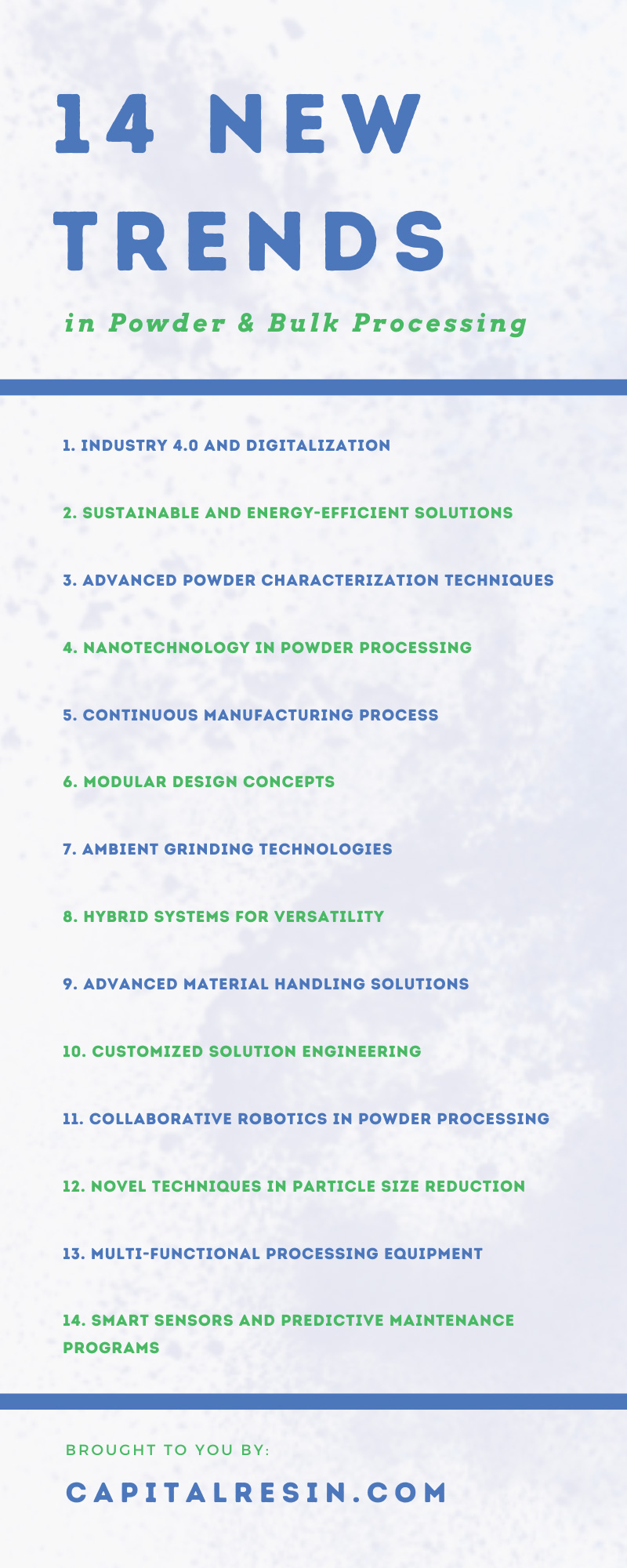Powder and bulk processing refer to the handling and management of dry materials, including powders, granules, flakes, and crystalline substances. This process involves a spectrum of operations, such as mixing, blending, milling, sieving, and packaging these materials. Powder and bulk processing is crucial in a variety of industries—food and beverage, pharmaceuticals, cosmetics, and construction—and plays a pivotal role in maintaining product consistency, improving quality, and optimizing production. Understanding the fundamentals of this process is key for any manufacturer because it can greatly influence the quality of the end product and operational efficiency.
Powder and bulk processing are constantly evolving, and new trends and innovations improve efficiency, performance, and sustainability. When you work in this business, you must be aware of the latest trends in order to optimize your decision-making processes. We will explore 14 new trends in powder and bulk processing and provide valuable insights to help you determine if you should jump on the bandwagon.
1. Industry 4.0 and Digitalization
The integration of Industry 4.0 and digitalization in powder and bulk processing is revolutionary. By adopting smart technologies, such as IoT (Internet of Things), big data analytics, and advanced process control (APC), you can optimize your operations and reduce downtime. These digital solutions also enable real-time monitoring of equipment performance and predictive maintenance cost savings.
2. Sustainable and Energy-Efficient Solutions
Sustainability and energy efficiency are growing in powder and bulk processing. Minimizing the environmental impact of operations has become a significant focus for businesses, leading to the development of energy-efficient equipment and practices. This includes adopting waste heat recovery systems, solar power, and energy-efficient motors and drives that reduce energy consumption.
3. Advanced Powder Characterization Techniques
Understanding the behavior of powders is crucial for efficient processing and product quality control. Advances in powder characterization techniques have enabled accurate measurements of vital properties—particle size, shape, distribution, moisture content, and flowability.
The adoption of advanced laser diffraction, digital imaging, and near-infrared spectroscopy (NIRS) techniques has improved the efficiency of powder characterization. These practices optimize processing parameters and improve product quality.
4. Nanotechnology in Powder Processing
Nanotechnology in powder and bulk processing is opening new possibilities for product innovation and process optimization. Nanoparticles and nano-coatings enhance material properties, such as strength, durability, and functionality. This trend may significantly impact industries like pharmaceuticals, cosmetics, and food and beverage. It enables the creation of innovative products with exceptional performance.
5. Continuous Manufacturing Process
The shift from batch processing to continuous manufacturing is another notable trend in the powder and bulk processing industry. Continuous processing enables fast processing times, reduced waste, and increased product consistency, leading to cost-effective operations.
Continuous processing offers better scalability, making it a promising solution for small-scale and high-volume production.
6. Modular Design Concepts
Modular design concepts allow businesses to implement powder and bulk processing systems in unique ways. These designs facilitate upgrades and meet the changing needs of manufacturers. Modularity also enables quick assembly and disassembly of parts, reducing downtime and lowering the total cost of ownership (TCO).
7. Ambient Grinding Technologies
Ambient grinding technologies are revolutionizing the size reduction process in powder and bulk processing. This technique involves grinding materials at room temperature, which reduces energy consumption and minimizes thermal degradation of the material. As a result, it enables manufacturers to produce high-quality products.
8. Hybrid Systems for Versatility
Hybrid systems combine the best features of different processing methods, resulting in systems that cater to many manufacturing requirements. By incorporating mixing, milling, and drying, companies can produce diverse powders and bulk solids without the need to invest in various systems.
9. Advanced Material Handling Solutions
The growing demand for powder and bulk processing has led to the development of new material handling solutions that reduce waste yet increase throughput. You can add pneumatic conveying systems, self-cleaning filters, and automated valve actuators to optimize material transfer at your company.
10. Customized Solution Engineering
Customized solution engineering offers tailor-made powder and bulk processing solutions for your clients who have specific needs. Engineered systems—employing various pieces of process equipment—allow you to meet unique product requirements and increase the quality of your products. Additionally, customized solutions might come with support from professionals who are familiar with operating the equipment.
11. Collaborative Robotics in Powder Processing
Another new trend in powder and bulk processing is the integration of collaborative robots (cobots) into various processing stages. Cobots can increase efficiency, precision, and safety in your operations. They are easy to deploy and operate and can work seamlessly alongside human operators. Additionally, you can program cobots to perform tasks such as loading and unloading hoppers, monitoring system parameters, and conducting routine maintenance with your team.
12. Novel Techniques in Particle Size Reduction
New methods for particle size reduction are in development to help manufacturers overcome challenges in milling and processing, such as excessive heat generation and product contamination. Spiral jet milling, cryogenic grinding, and high-pressure homogenization are gaining popularity in various applications. These methods offer increased efficiency, selective milling, and material-specific size reduction, allowing for greater control and uniformity in product particle sizes.
13. Multi-Functional Processing Equipment
As the demands of powder and bulk processing operations change, manufacturers have a growing need for versatile equipment. This trend focuses on the development of equipment that can perform multiple tasks, combine several operations into a single unit, or be reconfigured for different processes. This approach increases flexibility and allows manufacturers to adapt to changing market needs.
14. Smart Sensors and Predictive Maintenance Programs
The introduction of smart sensors in powder and bulk processing enables a shift toward predictive maintenance for equipment. These sensors continuously monitor equipment parameters, such as temperature, pressure, and vibration, to predict failures before they become critical. By identifying equipment issues early, you can reduce downtime and repair costs and streamline your processes.
Staying updated on trends in powder and bulk processing is crucial for tolling managers, as it drives innovation in the industry. By adopting these trends and keeping an eye on future developments, you can achieve a more efficient and sustainable operation.
Ready to stay ahead of the curve in powder and bulk processing? Choose Capital Resin Corporation, a leading phenolic resin manufacturer with a commitment to embracing the latest industry trends. We provide innovative and sustainable solutions tailored to your needs. Contact us today to explore how we can drive excellence and profitability in your operations.








